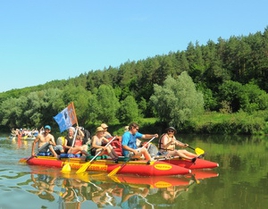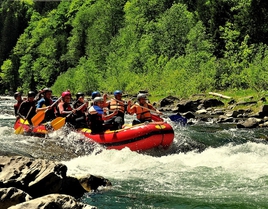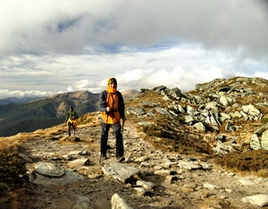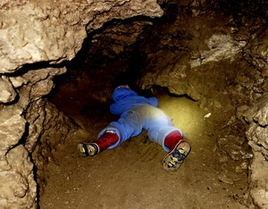Excursion Caves of Podillya: Krystalichna Cave, Verteba Cave, Atlantyda Cave
The caves are called the eighth wonder of the world, the kingdom of eternal darkness. Possession of the mysterious and unknown is open to those who dare to take a journey to the underground labyrinths created by nature.
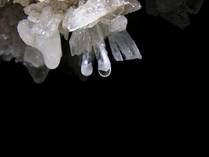 |
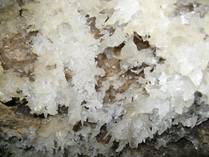 |
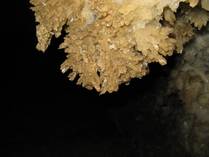 |
History of Borschivschyna contains many secrets and mysteries. The greatest of them is the natural piece of art - Gypsum Caves. At one time they served as a safe refuge for people, today - a godsend for speleologists, archaeologists, palaeontologists, and especially for tourists. And it is not necessary to go as far as New Athos.
Labyrinths of caves reach the length of several to 600 km (the largest in Europe - Optimistic Cave). The patterns on the walls of caves, stone shapes, clusters of crystals, tubular calcite stalactites, stalagmites and stalagnates leave unforgettable impression. The most noteworthy are caves Mlynky, Verteba, Ozerna, Optimistic and Kryshtaleva (Crystal). The region has already opened more than 100 caves, and every year the cadastral register is replenished with two - three new ones. According to specialists, the West Podillia has been explored only by one fifth of the underground cavities. It is easy to count - about 400 Ternopil caves wait for their Columbuses – speleologists.
The beauty of the caves is impossible to describe or convey through photography or film. This should be seen: crystals that play at light with all the colors of the rainbow, like Ural semi-precious stones, gardens of stalagmites - from the simplest to the fantastical in form; hanging garlands of stalactites, walls, ceiling, covered with frost of multicolored crystals; polished water walls, different coloring, multicolored nodules on the walls, underground lakes, rivers, waterfalls ... Yes, one must see it!
Find out more about Ternopil caves:
Caves of Podillya (table)
Underground labyrinths wait for their Columbuses
On caves formation
Protection of underground environment. Speleologist’s code of ethics
Krystalichna Cave
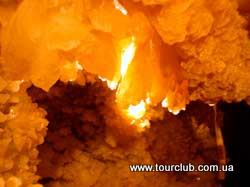
Krystalichna Cave is located in the village of Kryvche, on a narrow water parting plateau between the rivers Tsyhanka and Semeniv potik. It it considered to be the best in Ukraine.
The total length of the passage ways runs up to 23 km.
Apart the maze of corridors, there are big halls and galleries, walls of which are covered with snow white or colored crystals of secondary gypsum. Corridors are electricized. Krystalichna cave is practically dry and for trips there is no need to have wetsuit or special equipment. Krystalichna cave has already been well studied and equipped for visiting by tourists.
Every day tourists come over to Krystalichna to breathe in underground chill, train imagination on stone plexus and dancing shadows, savor local legends and meet local cave inhabitants – bats.
Labyrinths smoothly turn into amazing halls and corridors: “Zoologhichnyi” (Zoological), “Zavaliv” (Obstractoin), “Vuzlovyy” (Nodal), “Dyv” (Marvels) and others.
Numerous legends make the world of everlasting darkness more colorful. One of them dates back to the old times: to escape slavery during Mongol-Tatars invasion, Ukrainian girls searched escape in the caves. Thus, charming Natalka got into Krystalichna. The cave master, taking care of a young beauty, could not resist the wish to leave Nata next to him. Vain attempts of the girl to see the light of the day failed. Natalka took a decision to kill an insidious master. But during her attempt she only cut his hand. He got enraged and asked an enchantress to turn Natalya into a stone lizard...
Find out more about Krystalichna cave:
Krystalichna cave: underground pearl of Podillya
Krystalichna cave: history of discovery and research
Verteba Cave
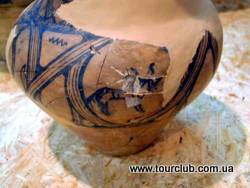 Verteba Cave is an underground museum of trypillya culture. The total length of the cave is about 8 km.
Verteba Cave is an underground museum of trypillya culture. The total length of the cave is about 8 km.
Peculiar features: dense passageways net; many ceramic women figurines were found here, and in one part under plate debris a mysterious male entombment of 25 skeletons was encountered, therefore the cave got its name "Naddnistryanski (Above Dniester) Pompeii".
The first evidence on a gypsum cave near the village of Bilche-Zolote dates back to 1822. That’s when a German publisher "Miscellen" spread information about first found traces of people and animal stay there.
There is an interesting and original labyrinth "Kaminna Solomka” (Stone Straw) in Verteba, where the ceiling surface is covered with dense “thickets” of tubelike calcite stalactites, the length of which is 10-12 cm. The cave was a refuge for trypyllya tribes, as evidenced by the examples of ceramics, so it is for contemporary generation of outcasts and persecuted. There is an evidence that the whole Jewish community found refuge here, an UPA (Ukrainian Insurgent Army) propaganda center worked here as well.
Permanent residents were cave bats, apart from people. Even now they gather here at a mating period, endowing the underworld with mystery and enigma.
Verteba is a branch of Borschiv museum of regional ethnography.
It is well adapted for visiting: the passageways are cleared here, trypillya life diorama has been equipped, inscriptions and plates have been restored, though one shouldn’t descend into eight kilometers labyrinth without light and a guide.
Find out more about Verteba cave:
In the palaces of ancient Verteba
History of Verteba cave discovery and findings in it
Atlantyda Cave
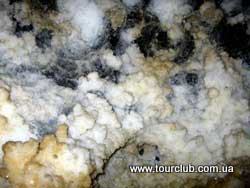 Among karst caves of Ukraine Atlantyda takes a unique place. It is located in the scenic valley slope of the river Zbruch near the village of Zavallya, of Kamyanets-Podilskyi district, Khmelnytskyi region.
Among karst caves of Ukraine Atlantyda takes a unique place. It is located in the scenic valley slope of the river Zbruch near the village of Zavallya, of Kamyanets-Podilskyi district, Khmelnytskyi region.
The legend tells that at the upper part of the slope, over the cave, there once was a small church. One day it “collapsed” into a karst doline, the village was called Zavallya (doline) after it. The cave was not known at that time, but people realized that such phenomena are linked with cavities in the ground.
The cave’s secondary sediments are of great interest. They are presented by different genetic types.
Gravity sediments are connected with rock slides in the cavity ceiling (partial slide) and with dolines (full slide of the cave ceiling). Slide-gravity sediments are presented with fragments and blocks of gypsum on the cave floor, and doline-gravity ones – with huge doline bodies, consisting of blocks and clay formations, occurring over gypsum plasters. Such doline bodies separate the cave system into some fragments.
A variety of gypsum crystals that grew on the cave walls and ceilings due to lakes, supersaturated with calcium sulphate, make the cave a unique mineralogical museum. From thin needles, which form tiny but dense thickets to huge, 1.5 m long, crystalline aggregates – this is a size range of gypsum crystals of the cave. Abundance of mineral forms and colors of crystal structures can impress anyone. Emotions and associations caused by contemplation of these magnificent works of nature, to some extent are concentrated in the names of grottoes and a hall: "Nizhnist"(Tenderness), "Kvity"(Flowers), "Zolota Osin"(Golden Autumn), "Chervoni Maky"(Red Poppies), "Khram Boghiv"(Temple of the Gods) and so on.
Find out more about Atlantyda cave:
Atlantyda Cave
